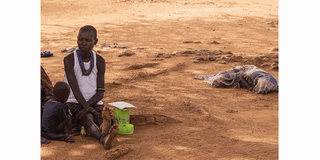Address root cause of Karamoja famine

A mother and her children during a nutrition screening at Nadunget Health Centre in Nadunget, Karamoja Sub-region, Uganda, on May 24. In Karamoja and some parts of Lango sub-regions, there are reports of people dying of hunger as a result of food shortage. PHOTO/AFP
What you need to know:
The issue: Famine in Karamoja.
Our view: The various stakeholders need to get back to the drawing board to find lasting solutions for Karamoja. But most urgently, the hundreds of deaths blamed on hunger should be stopped.
Karamoja Sub-region has been trending on social media platforms this week. And as usual, for the bad reasons.
Images of malnourished women and children made the rounds as news of people starving to death was picked up by mainstream media.
In Parliament, Napak Woman MP Faith Nakut told lawmakers that as of July 8, more than 600 starvation-related deaths had been recorded in Kotido, Napak, Moroto and Kaabong.
The situation is being handled as something that just occurred, but the warning signs were there from the beginning of the year.
In late January, it was reported that women and children fleeing famine were arriving in Agago District in droves.
Local leaders reported tens of lorries ferrying the Karimojong into the district, with a warning to truck drivers to desist from transporting the women and children since they intended to turn away those that had arrived.
In their reasoning, the leaders said it was a matter beyond their capacity to handle given the numbers of people arriving, arguing that it was for the central government to handle. It seems not much was done since it is now a full-blown crisis.
But this is not the first time that famine is hitting the sub-region. Years on end, famine in Karamoja has been fodder for news and development partners.
And this time round, low crop yields as the major cause of famine has been compounded with locust invasion followed by prolonged drought and floods, Covid-19 disruptions and an explosion of insecurity reportedly fanned by cattle rustlers.
That government has a dedicated ministry for Karamoja affairs is laudable, and the incredible work that development partners are doing in the sub-region cannot go without praise. But the bottom line is that insecurity, poverty and famine still remain a major stumbling block despite years of intervention.
The various stakeholders need to get back to the drawing board to find lasting solutions for Karamoja. But most urgently, the hundreds of deaths blamed on hunger should be stopped.
Amid this ping-pong between government of Uganda and the World Bank on whether the country has achieved middle income status or not, government comes out looking not so good.
It is one thing to claim you have attained middle income status, but the achievement is not worth celebrating if news is emerging that up to 600 of your citizens could have starved to death, with many more on the verge.
The Shs135b earmarked by government this week for Karamoja food relief is welcome, but comes a little too late. The food needs to be procured and distributed without delay and experts need to re-evaluate the development progress in the region.
Our commitment to you
We pledge:
- To be accurate and fair in all we do.
- To be respectful to all in our pursuit of the truth.
- To refuse to accept any compensation beyond that provided by Monitor Publications Ltd. for what we do in our news gathering and decision-making.
Further, we ask that we be informed whenever you feel that we have fallen short in our attempt to keep these commitments.




